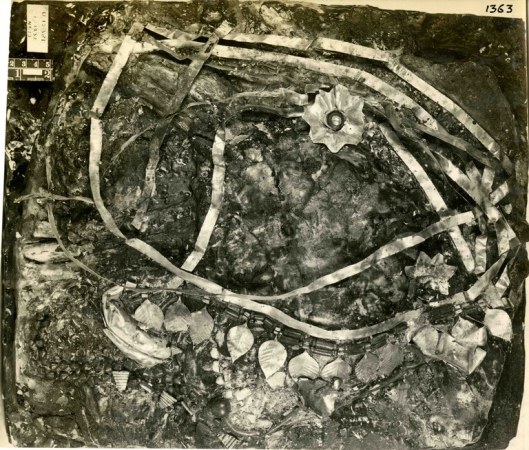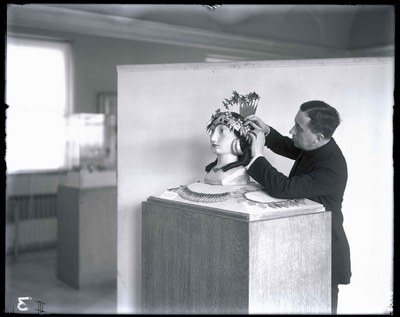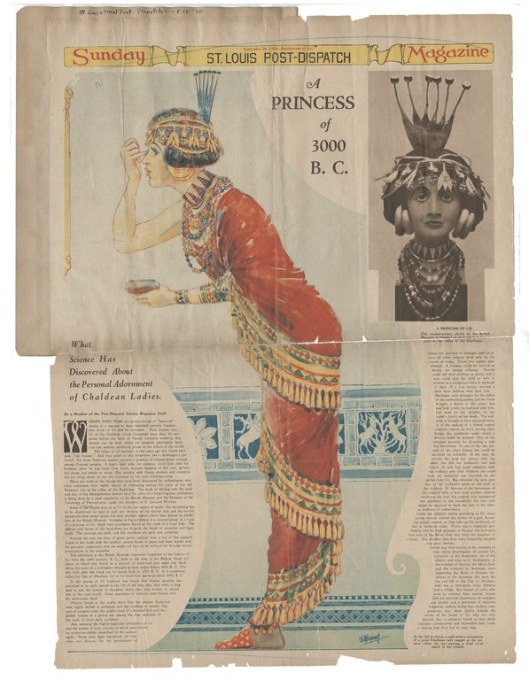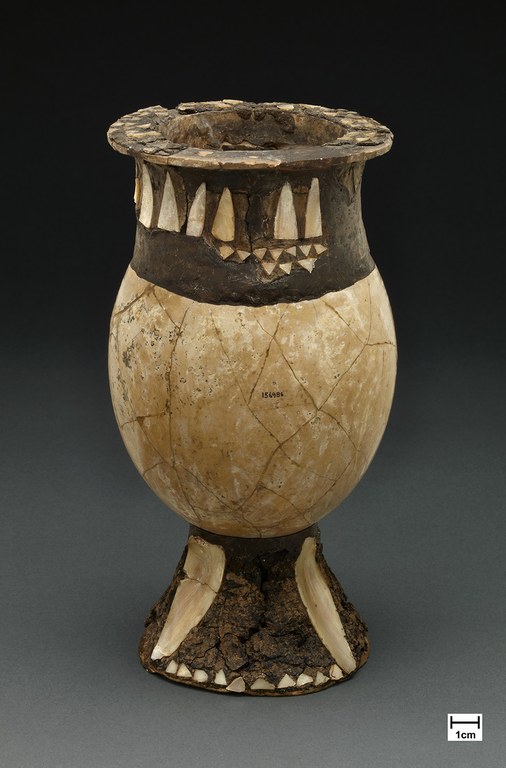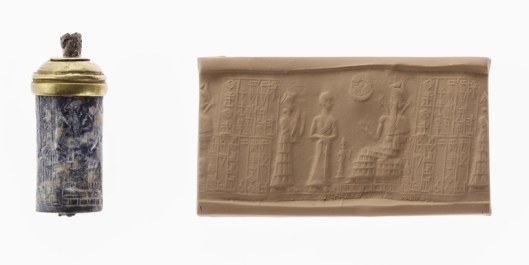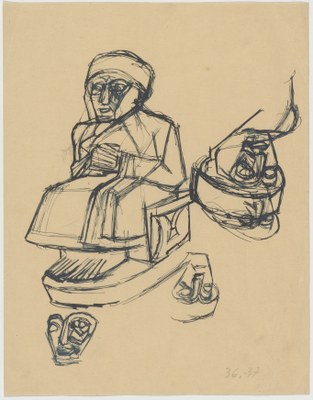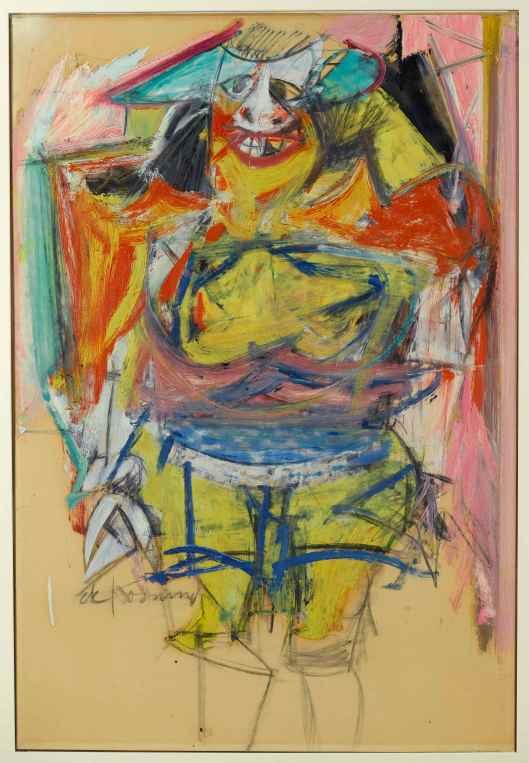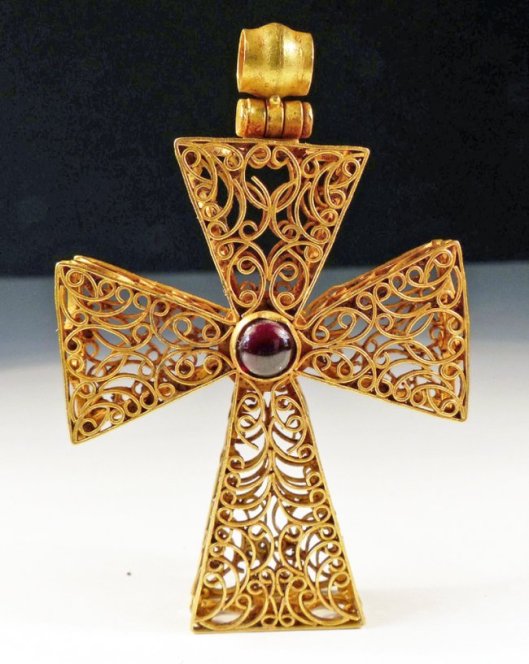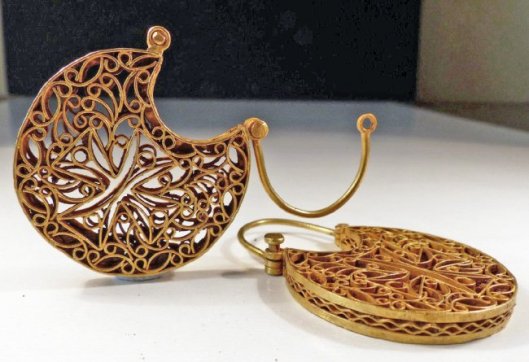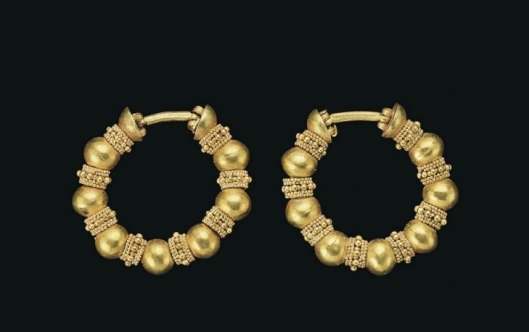Étiquettes
'Cup with Nude Hero, 'Seated Gudea: After a Sumerian Sculpture', 'The Invisible Enemy Should Not Exist: Seated statue of Scribe Dudu', 1953-54, Alabaster, Alberto Giacometti, and Lions', Bitumen, Black Limestone, Bronze, Bulls, ca. 1935, ca. 2000 bce, ca. 2500-2350 bce, ca. 2500–2300 bce, ca. 2650-2550 BCE, ca. 2900–2600 bce, ca. 3000-2650 bce, Cylinder Seal, Eshnunna, Eshnunna (Tell Asmar), Gold, gypsum, Half Figure II, Henry Moore, Iraq Expedition House, Jananne al-Ani, Khafajah (Nintu Temple), Kish, Lapis Lazuli, Léon Legrain, Leonard Woolley, May 1991 [Gulf War Work], Michael Rakowitz, Mother Of Pearl, Ostrich Egg, Ostrich-Egg Vessel, Pencil on paper, Puabi's headdress and cloak, Shell, Standing Male Figure, Tell Agrab (Shara Temple), Tell Asmar, Ur, Willem de Kooning, Woman
Standing Male Figure. Alabaster, Shell, Lapis Lazuli, H. 23 cm; W. 8 cm; D. 7 cm. Khafajah (Nintu Temple), ca. 2650-2550 BCE. Khafaje Expedition. Penn Museum: 37-15-28 © Bruce White.
NEW YORK, NY.– A major exhibition at the Institute for the Study of the Ancient World examines the fascinating process through which archaeological objects are transformed from artifacts to artworks and, sometimes, to popular icons, as they move from the sites in which they were discovered, to mass media, to museum displays. From Ancient to Modern: Archaeology and Aesthetics includes some 50 outstanding ancient Mesopotamian objects and more than 100 illuminating documents, photographs, and drawings, with a focus on excavations from the 1920s and 30s, when many important finds were unearthed at sites in present-day Iraq. It reveals the role of archaeologists, art historians, journalists, museum curators, and conservators in constructing identities for ancient artifacts that not only resonated with Western popular and artistic culture, but that also positioned the finds as integral to the history of Western civilization.
In a first for ISAW, From Ancient to Modern includes ten works of modern and contemporary art, demonstrating the evolving influence that archaeological artifacts, and the way they were presented, had and continue to have on artists of our day.
The exhibition has been curated by Jennifer Chi, ISAW’s Director of Exhibitions and Chief Curator, and Pedro Azara, Professor of Aesthetics and the Theory of Art at Polytechnic University of Catalonia. It will remain on view through June 7, 2015.
Dr. Chi states, “From Ancient to Modern: Archaeology and Aesthetics proposes some provocative ideas about the way that archaeological artifacts have been presented to and perceived by the public. With ancient artifacts, related material, and a selection of modern and contemporary art, the exhibition creates an unprecedented and multi-layered view of some of the most famous sites in the history of archaeology, and, importantly, illustrates the ongoing life of ancient objects. ISAW is grateful to the Penn Museum for its extremely generous loans to the exhibition. We also owe many thanks to the Oriental Institute of the University of Chicago for its ongoing support, which included opening the doors to its rich permanent collection and archive.”
From Ancient to Modern opens with a gallery devoted to a number of Mesopotamian archaeological sites. Concentrating on Ur, perhaps best known as the birthplace of the biblical figure of Abraham, and several sites in the Diyala River valley, the display includes many nowiconic objects. These are shown alongside documentation that opens a window onto day-to-day life at the excavations while illustrating the ways in which the finds they uncovered were carefully described and presented to the press and public in order to garner maximum appeal. Select objects are followed as they are strategically presented to an international audience, effecting their transformation from archaeological item to aesthetic object.
Ur
The most comprehensive archaeological exploration of Ur began in 1922, with a team led by British archaeologist Charles Leonard Woolley. As seen in a number of photographs that illuminate life at the site, Woolley was a dashing figure, sometimes sporting a fedora, a tight jacket, and even dress shoes amid the dust and dirt of an active dig. His team of international archaeologists included one woman, the widow Katharine Keeling, whom he would marry. (Another archaeologist there, Max Mallowan, would later marry Agatha Christie, whom he met on the site. Christie’s mystery Murder in Mesopotamia provides a rich picture of life at the dig.)
Leonard Woolley brushing an artifact, Ur. Photograph, H. 11.5 cm; W. 15.3 cm, ca. 1925. Courtesy of the University of Pennsylvania Museum of Archaeology and Anthropology Penn Museum © Courtesy of Penn Museum
The most spectacular of Woolley’s discoveries was the tomb of Queen Puabi, represented in the exhibition through exceptionally well preserved, 4,500-year-old artifacts on loan from the Penn Museum. The tomb contained a remarkably rich concentration of jewelry, found on and with the queen’s body. Much of this was discovered as masses of gold and semi-precious beads, pendants, and other individual components with which the expedition team worked to re-create the original jewelry. The exhibition includes Puabi’s richly beaded cloak and belt, re-created from extraordinary numbers of carnelian, lapis lazuli, and gold beads, and a dazzling headdress comprising lavish gold components that include a massive floral-shaped comb, fillets of pounded sheets of gold, and botanical wreaths.
Jewelry in situ, Ur. Photograph, H. 13.3 cm; W. 15.5 cm, 1929. Courtesy of the University of Pennsylvania Museum of Archaeology and Anthropology, Penn Museum: 1363 © Courtesy of Penn Museum
An especially interesting example of the ways in which Woolley and his team re-created Puabi’s jewels is the so-called Diadem of Puabi, which the excavation team assembled from a pile of thousands of lapis beads and gold pendants found in the tomb. In its original reconstruction, represented in the exhibition through photographs, the piece has striking similarities with headbands worn during the 1920s and 30s, including a contemporaneous example designed by Cartier, though Woolley indicates in his note cards that he was reconstructing it as he felt the archaeological evidence indicated. In fact, although the Woolleys’ version of the headdress was aesthetically pleasing, more recent research by the Penn Museum indicates that it was not in fact a single ornament but most likely a series of beaded strands with pendants.
Léon Legrain adjusting Puabi’s headdress. Photograph, H. 11.5 cm; W. 15.3 cm, 1929. Courtesy of the University of Pennsylvania Museum of Archaeology and Anthropology © Courtesy of Penn Museum
Presented to the public at an exhibition at the British Museum and via strategically cultivated, widespread media coverage, Puabi and her astounding dress assumed an aesthetic aura that radiated the apparent power of its original owner and ignited a frisson of identification with the onetime queen that helped gain visibility for the excavation at Ur. A selection of newspaper and magazine clippings document the overwhelming popular response to the reconstructed image, revealing that Queen Puabi soon became something of a fashion and lifestyle sensation, the subject of articles with such titles as “Ancient Queen Used Rouge and Lipstick.”
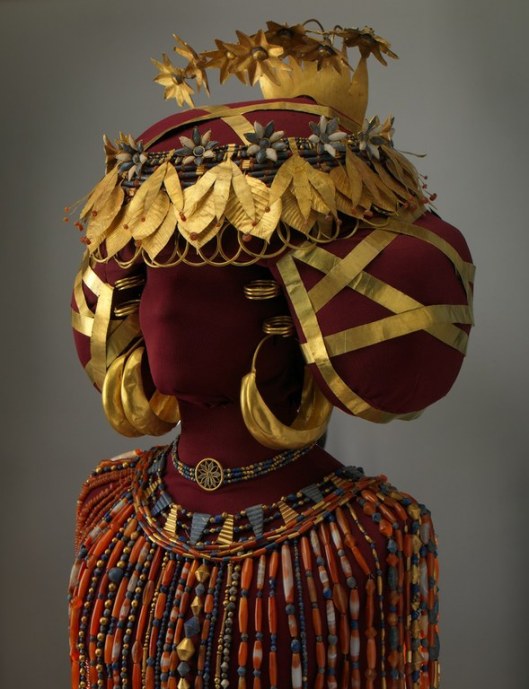
Puabi’s headdress and cloak. Gold, Ur, ca. 2500–2300 bce. Joint Expedition of the British Museum and of the Museum of the University of Pennsylvania, 6th season, 1927-1928. Penn: B16992A (Hair Ring), B17709 (Wreath), B16693 (Decorative Comb), B17710 (Wreath), B17711 (Wreath), B17711A (Hair Ribbon), B17712A, B (Earrings), 98-9-9A, B (Hair Rings), B17708 (Frontlet), B16694 (Necklace), 83-7-1.1–83-7-1.89 (Cloak) © Bruce White
“A Princess of 3000 bc”, St. Louis Post-Dispatch Sunday Magazine, September 28, 1930. H. 59.3 cm; W. 45.6 cm. Courtesy of the University of Pennsylvania Museum of Archaeology and Anthropology © Courtesy of Penn Museum
Diyala River Valley
If the jewels from Ur largely existed for the public within the aesthetic of popular design and culture, the statuary found in the Diyala region, north of Ur, constituted the first early Mesopotamian artifacts to be studied and presented as works of art. Between 1930 and 1937, four expeditions on behalf of the Oriental Institute led by Henri Frankfort, a Dutch-born, London-educated archaeologist and historian of classical art, uncovered hundreds of Sumerian statues located in architectural contexts, many identified as temples. Dating from the mid-third millennium BCE, the statues included standing male and female figures with hands clasped in front, perhaps in worship, and seated cup-bearing males, all considered the paradigms of their types.
Interior of the Iraq Expedition House, Tell Asmar. Photograph, H. 17.9 cm; W. 13 cm, January 29, 1934. Courtesy of the Oriental Institute of the University of Chicago. OIM: As. 1098 (P. 24084) © Courtesy of the Oriental Institute of the University of Chicago
Standing Male Figure. Gypsum, Alabaster, Shell, Black Limestone, Bitumen, H. 29.5 cm; W. 12.9 cm; D. 10 cm, Eshnunna (Tell Asmar), ca. 2900–2600 bce. Fletcher Fund, 1940. MMA: 40.156 © The Metropolitan Museum of Art. Image source: Art Resource, NY
Archaeology and Aesthetics contains ten of these exquisite statuettes, representing both the traditional types and variations within them. They are juxtaposed with articles, letters, field cards, notebooks, photographs, and other complementary material.
Viewed together, the archival material sheds light on the ways in which these artifacts were approached from an aesthetic perspective and placed within an art historical context. For example, Frankfort (who would become director of the Warburg Institute, in London) was among the first archaeologists to use the word “sculpture” to describe ancient statuary, and his descriptions frequently used the vocabulary of art historical formalism. In articles, letters, and books, he stated that the creators of the figures had “followed abstraction to its utmost limits,” and repeatedly described the statues with such terms as “form,” “mass,” and “space”—all associated with the description of early- and mid-twentieth-century art. In the introduction to his well-known book More Sculpture from the Diyala Region, for example, he stated that the statuary was marked by “a vigorous and inventive stylization with obvious traces of experiment.” The focus on form was also used to link these Sumerian objects to so-called “primitive” art, from which many contemporary artists had drawn inspiration, and to describe them as “universal,“ a term often used in association with fine art and one that helped to position the statues as the origin point of Western art.
Cup with Nude Hero, Bulls, and Lions. Stone, H. 15.2 cm; W. 7.9 cm, Tell Agrab (Shara Temple), ca. 3000-2650 bce. Iraq Expedition of the Oriental Institute, 1930–1937. OIM: A17948 © Courtesy of the Oriental Institute of the University of Chicago
Like the written materials, the expedition’s visual documentation of the sculptures was meticulous, scholarly, and focused on the aesthetic. Images of the objects drawn on field cards, for example, were carefully placed vis-à-vis the white space of the card, with brief descriptions positioned so as to balance the image. Similarly, many expedition photographs isolate a single statue against a dark backdrop, with no indication of the temple, palace, or tomb in which it was found, giving the image the timeless quality that imbues so much art photography.
Ostrich-Egg Vessel. Ostrich Egg, Bitumen, Mother-of-Pearl, H. 22.5 cm; W. 11 cm; D. 11 cm, Kish, ca. 2500-2350 bce. Lent by the Field Museum of Natural History. Field: 156986 © Photo: John Weinstein
The ramifications of Frankfort’s aesthetic perspective can hardly be overstated. It had lasting impact not only on ongoing scholarship on material from Ur, but also on the entire discourse on the origins of Western art, as well as on modern artists who were inspired by the objects displayed in European and North American museums, where they were generally installed in vitrines, without visual or didactic reference to their contexts.
Cylinder Seal, with inscription to Bilalama and modern impression. Gold, Lapis Lazuli, Bronze, H. 4.3 cm; Diam. 1.5 cm, Eshnunna, ca. 2000 bce. Iraq Expedition of the Oriental Institute, 1930-1937. OIM: A7468 © Courtesy of the Oriental Institute of the University of Chicago
The Past as Present:
Modern and Contemporary Art From Ancient to Modern continues with a gallery devoted to twentieth- and twenty-first century artistic responses to ancient Mesopotamian objects. As the artifacts began to make their way into museums across pre-War Europe, Alberto Giacometti, Georges Bataille, Henry Moore, Barbara Hepworth, and others drew inspiration from Sumerian figures, while later in the United States, artists including Willem de Kooning, David Smith, and the poet Charles Olson saw in Sumerian objects and poems a kind of energy and vision they believed had been lost.
For Giacometti, who strove in his work to express the human condition, the Sumerian heads he saw at the Louvre represented a time when humans were integrally related to, rather than alienated from, both the visible and spiritual worlds. Archaeology and Aesthetics includes four drawings (both ca.1935) in which the artist explores the image of the Sumerian ruler Gudea, emphasizing the geometric planes and patterns in ancient sculptural portrayals of the king, an example of which is on view in this gallery.
Alberto Giacometti, ‘Seated Gudea: After a Sumerian Sculpture’. Pencil on paper, H. 26.9 cm; W. 21 cm, ca. 1935. Courtesy of the Alberto Giacometti Estate. GF: 1994-0704 © Alberto Giacometti Estate/Licensed by VAGA and ARS, New York, NY 2014
Moore, too, was inspired by Sumerian sculptures, which he saw at the British Museum. Like Giacometti, he felt that they contained something essential about the human condition. Moore was especially fascinated by the relationship between the head and clasped hands, as seen in the statuary unearthed by Frankfort, finding there, as he put it, “a wealth of meaning.” The exhibition includes Moore’s Seated Figure and Half Figure II (both 1929), each depicting, with simple, powerful forms, a female figure with clasped hands.
Henry Moore, Half Figure II. Cast concrete, H. 39.4 cm, W. 23 cm; D. 17 cm, 1929. The Robert and Lisa Sainsbury Collection, SCVA: UEA 79 © Robert and Lisa Sainsbury Collection, Sainsbury Centre for Visual Arts, University of East Anglia, UK
Later, the strongly frontal pose and staring, hypnotic eyes of de Kooning’s iconic “Woman” series, represented here by two oil-on-paper works (1953–54 and 1967), also evoke Sumerian sculpture. Indeed, the artist, who saw artifacts from the Diyala Valley site of Tell Asmar at the Metropolitan Museum of Art, noted that the grins on the faces of his “Woman” paintings are “rather like the Mesopotamian idols.” The examples here are shown next to an iconic Tell Asmar worshipper statue that de Kooning had surely seen at the Museum.
Willem de Kooning, Woman. Oil on Paper Board, H. 90.8 cm; W. 61.9 cm, 1953-54. Gift of Mr. and Mrs. Alastair B. Martin, the Guennol Collection. TBM: 57.124 © The Willem de Kooning Foundation/Artists Rights Society (ARS), New York
Reflecting contemporary viewpoints, many artists today return archaeological artifacts to their role as windows onto human history and cultures rather than as aesthetic objects. Archaeology and Aesthetics highlights this with work by Jananne al-Ani, who was born in Kirkuk, Iraq, and lives and works in London, and the Chicago-based Michael Rakowitz, who is of Iraqi-Jewish heritage. Both al-Ani and Rakowitz create art expressive of the traumatic loss of human heritage caused by wars and spreading conflict in the Near- and Middle East.
Al-Ani’s subtle and moving Untitled May 1991 [Gulf War Work] takes the form of a grid of photographs of subjects ranging from family members, to Sumerian artifacts, to news images of what has become known as “the first Gulf War.” The work mixes individual with collective histories, evoking the loss of the artist’s family history and cultural heritage while providing the personal perspective of inhabitants that is so often missing from media portrayals of war.
Jananne al-Ani, Untitled, May 1991 [Gulf War Work]. Silver gelatin prints on paper, 20 units: H. 20 cm; W. 20 cm (each), 1991. Courtesy of the artist. IWM: ART 16417 © Courtesy of Jananne al-Ani Estate and the Imperial War Museums.
Rakowitz’s powerful, eloquent installation The Invisible Enemy Should not Exist (Recovered, Missing, Stolen) (2003) comprises lifesized reproductions of Mesopotamian artifacts that are missing (or were in 2003) from the collection of the National Museum of Iraq, in Baghdad. The work varies in size depending on where it is installed; at ISAW it comprises 25 reproductions. With each object made of a mass-produced, readily available Iraqi product, including packaging of Middle Eastern foodstuffs and Arab newspapers, The Invisible Enemy draws a parallel between their cheap disposability and the treatment of the priceless evidence of human heritage that was looted or treated as waste after the 2003 invasion of Iraq.
Michael Rakowitz, ‘The Invisible Enemy Should Not Exist: Seated statue of Scribe Dudu’ (IM55204), Middle Eastern Packaging and Newspapers, Glue, H. 54 cm; W. 24.5 cm; D. 34.5 cm, 2014. Courtesy of the artist and Lombard Freid Gallery: 12183 © Courtesy of the artist and Lombard Freid Gallery



